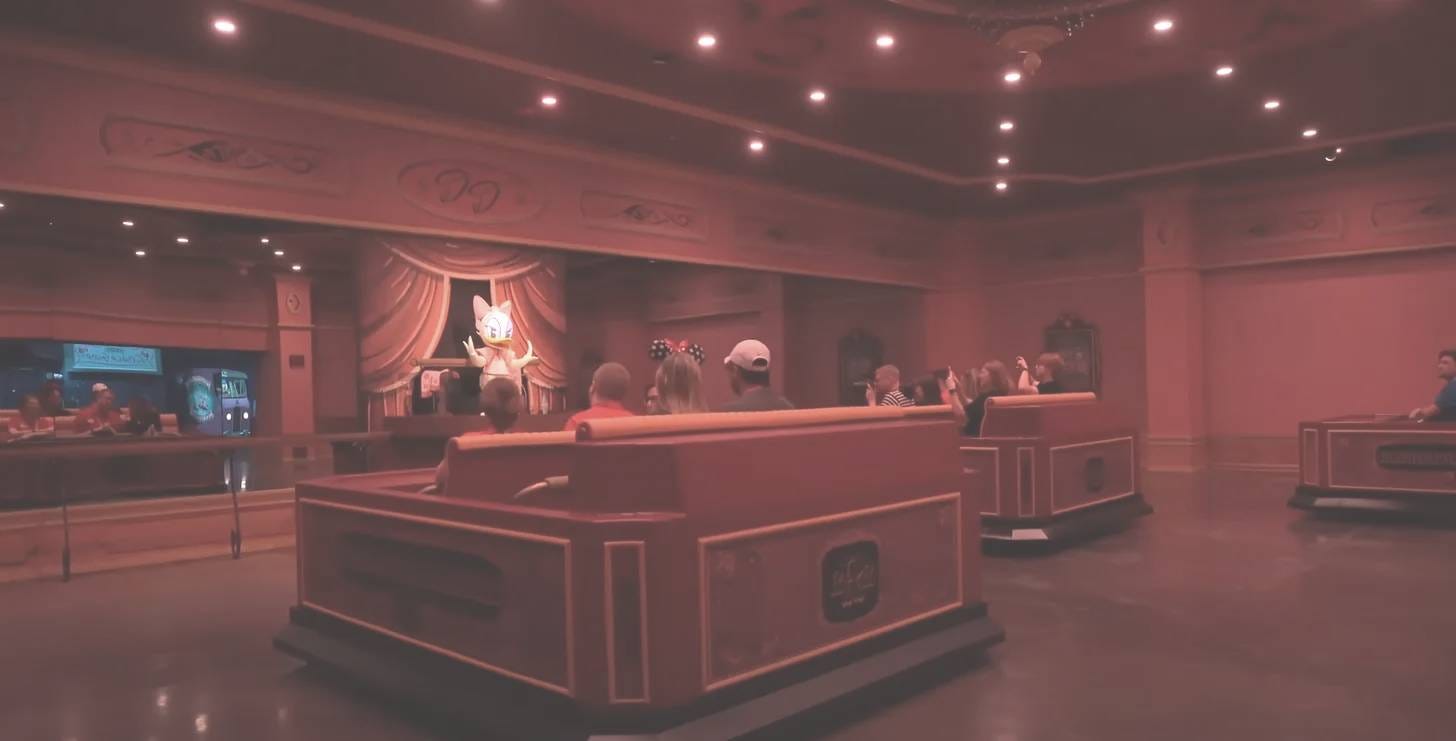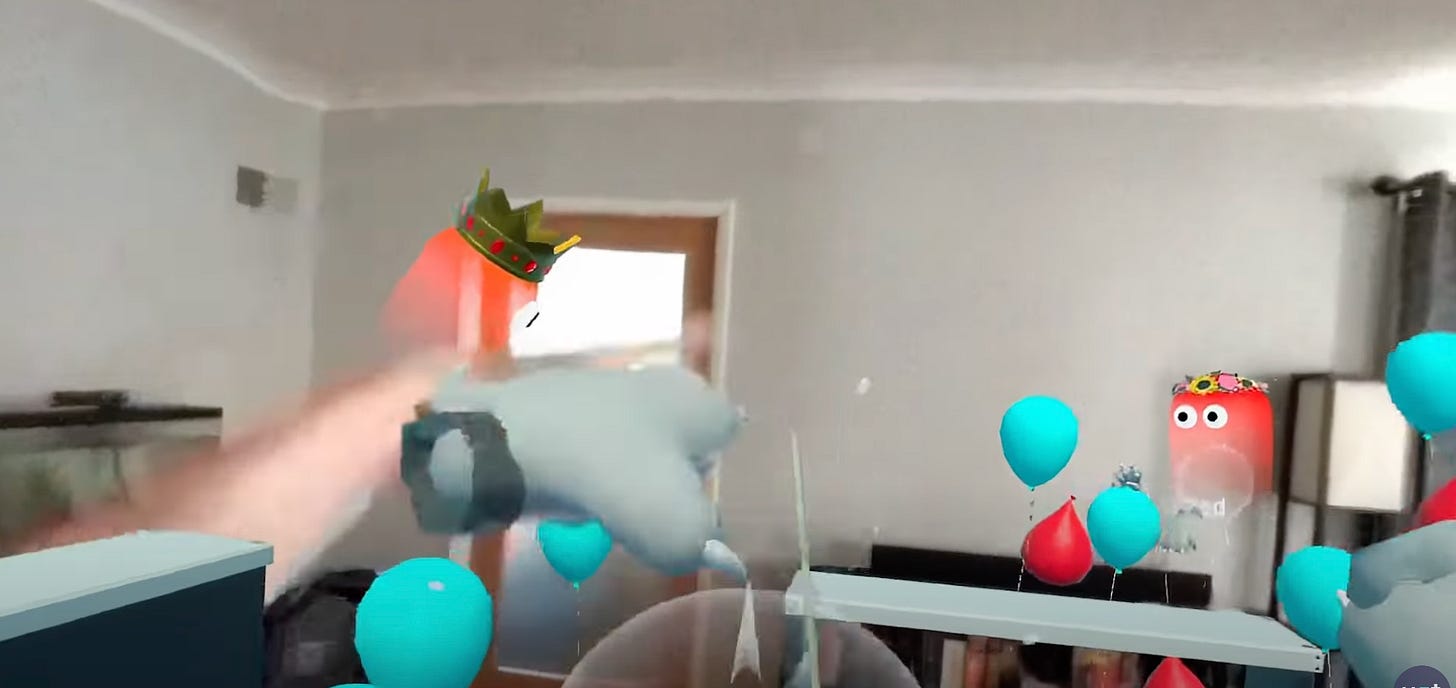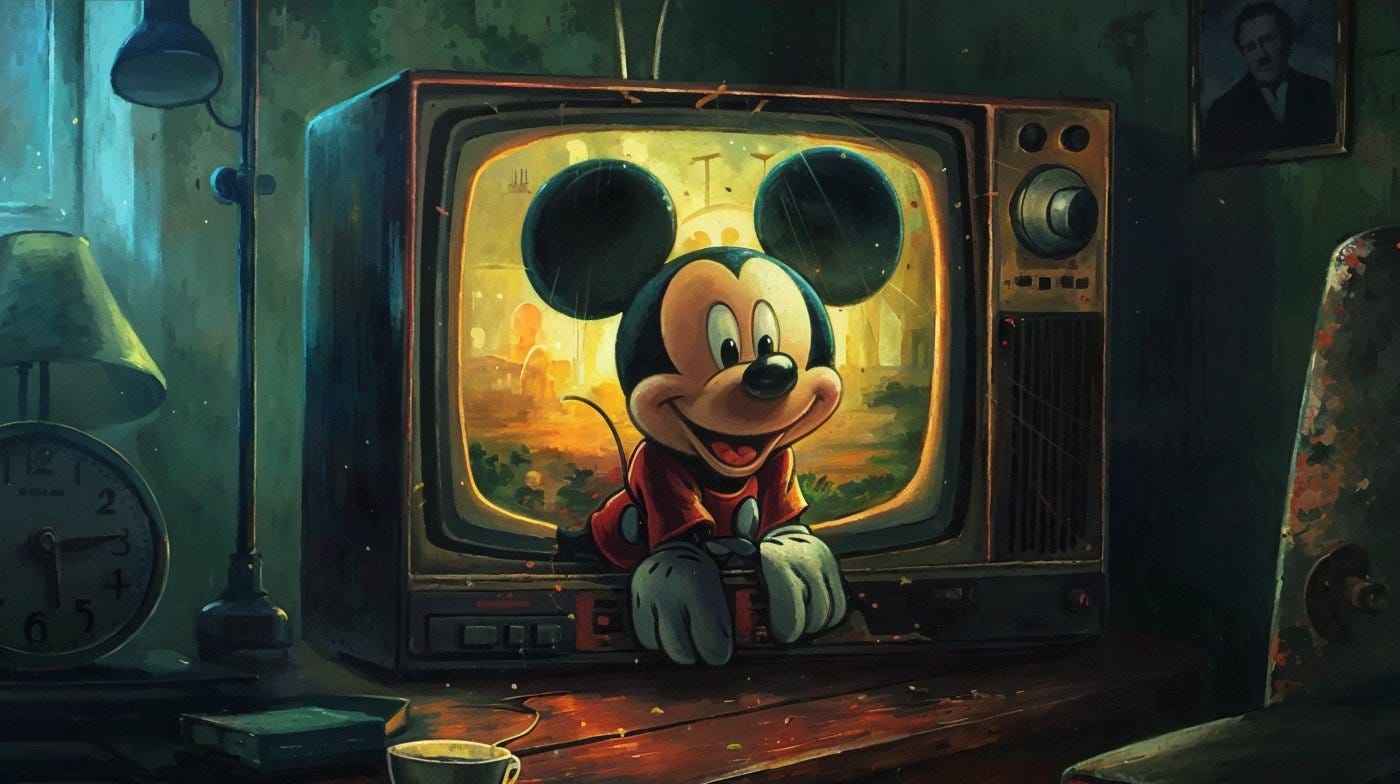Disneyland on VHS
The following ride has been modified from its original version. It has been formatted to fit this house.
When Disneyland opened in 1955, it had about a dozen rides. Two of them - “Autopia” and “Indian War Canoes”1 - gave you a vehicle you had to steer yourself. All of the rest were on tracks. So it’s not surprising that the newest ride at Disneyland is yet another train - Mickey & Minnie’s Runaway Railway. What is surprising is that this train has no tracks. It’s a fun example of Venkatesh Rao’s oozification:
Oozification is the process of recursively replacing systems based on numerous larger building blocks, governed by many rules, with ones based on fewer, smaller building blocks, governed by fewer rules, thereby increasing the number of evolutionary possibilities and lowering the number of evolutionary certainties.
Spoiler alert: Disney rides have fun surprises, and I will spoil one of them. My goal is to explore technology and family vacations, not Disney or theme park fandom.
When you finally reach the front of Mickey’s hour long line, train engineer Goofy pulls his locomotive into the station, and you foolishly board one of the four cars behind him. Together, you chug through green countryside and into a foreboding tunnel, where Mickey accidentally drives his car into a switch lever right as your train is going over the switch. Goofy and his locomotive head left as planned, but you and the other passengers veer right under an ominous “KEEP-OUT” sign.
Right away, each of the four cars start to spin and dart off on their own seemingly random paths through projector-illuminated dioramas. I had not noticed that the train tracks at the station were only paint, so it’s a great subversion of your expectations to realize that it’s not a train after all, and anything can happen. Even the car in front of you isn’t giving any hints.
The unshackled ride designers waste no time showing off what their atomized train can do. One minute you’re bobbing along a river.
Then each car darts into its own wraparound dome to go over a waterfall using a kid-friendly purely visual effect, no physical tilting.
And then you go back to the room you just came out of, except now you’re underwater
The entire ride has exactly three degrees of freedom - x/y translation and rotation. If they really wanted to, the Imagineers could have the ride up and running inside the back five aisles of a Costco. In terms of competitive moat, in a way this ride seems like a big step backwards for Disney’s theme park real estate.
But as long as Florida’s rising wet bulb temperature doesn’t start killing off castmembers faster than Disney can hire them, I bet they’ll be okay. Because the most magical part of the ride is a social experience. A bit after the underwater ordeal, you find yourself in a dance studio led by Daisy the duck.
Like any dance studio, the room has a large mirror so you can see yourself and all the other riders laughing as you waltz and pirouette around each other. Rollercoaster tracks can’t do that!
Disney calls these cars AGVs, for Autonomous Guided Vehicles. The first ones were deployed in 1994 for the “Tower of Terror” ride. These early AGVs move slowly over a simple path, and eventually end up in an elevator where they are pulled up and down, adding a thrilling z-translation to the experience.
In 2014 the AGV technology got an upgrade for Remy’s Ratatouille Adventure, and a further upgrade for 2019’s Star Wars: Rise of the Resistance. The Star Wars ride was so much fun that I don’t want to spoil it, but I think there’s no harm in spilling Ratatouille’s beans. The ride puts four passengers on a small tilting platform above a mouse-shaped AGV. Like the dance scene with Minnie, the Remy ride is inherently social. Each family has become a mouse, and you have assembled into a cooperative pack, frantically dodging boots and oven fires. The tilting platform adds physical cues to make the video projections more convincing.
I assume one of these AGVs costs about as much as a Lamborghini, and they spend a lot of their ride time parked inside small hemispherical theatres, which I couldn’t help but notice was an awfully expensive and frankly low-quality VR headset. So how long until Disneyland gets released on VHS?
In terms of technical capacity, I think it’s underestimated how much of a theme park ride experience the lowly Quest 3 from 2023 can already deliver. UrGamingTechie has a great overview video of some local multiplayer games available for Quest.
They have games where you map out the walls and furniture in your house, then your walls and furniture are replaced by crates and fences as you defend a virtual outdoor fort from invading skeletons. They have games where your house stays where it is, but is filled with virtual items to collectively interact with:
And best of all, they have games where you can draw persistent 3D sculptures around your house. With good enough tracking, this can be the ultimate fusion of drawing on the walls and pillow forts.
Unfortunately, the tracking on a Meta Quest 3 is not good enough for pillow forts. Crawling with your head close to the floor or walls is a worst-case scenario for camera-based tracking, especially if you’re moving from one room to another while you’re doing it. Achieving pillow-fort levels of accuracy is likely going to require prosumer hardware for the foreseeable future, with tedious external tracking beacons scattered around the house, and sensors on the front and back of the user’s head to prevent occlusions.
But with an event-based model like Disneyland, this high-end hardware could be amortized across many “guests” - just like you don’t have to buy your own lamborghini-priced AGV to visit Disneyland. To take a family of four to one of Disney’s midrange hotels for two nights and visit the parks for three days costs $2,500, plus airfare. You can buy four brand new Meta Quest 3’s for $2,000, so if you can share a headset across even just 10 guests before it breaks that leaves plenty of room for upscale hardware.
It’s easy to imagine a deluxe staycation package. You scan your house with your phone, and pay $2,500 to Disney. Friday morning, a box of indoor tracking beacons and Apple Vision Pro’s show up at your doorstep, including an extra in case one breaks. At the platinum level you also get a couple rumble pads for the kids, for when the rocket is taking off or the monster is stomping.
The following ride has been modified from its original version. It has been formatted to fit this house.
The most promising aspect of VR gaming is how little stagecraft developers are using so far. Take the waterfall trick from earlier. Imagine your family “paddling” a canoe together in the kids’ bedroom. You find a submarine, and paddle towards it. You all climb into the closet, and down you go. Climb out of the closet, and now you are divers, walking around in heavy suits on the ocean floor as Nemo flits between you.
Timon and Pumbaa know everyone’s name, and a faithful digital impersonation of Nathan Lane is cracking context appropriate jokes with you as you eat grubs off the carpet. Nahhhhh, svetingahhhhhh, yagaveech, yaga vah yells Dad as he holds the family dog out over the banister of pride rock. Don’t drop her!!! After a weekend of playing deluxe pillow fort at home, the professional quality headsets and tracking beacons get shipped back to Disney on Monday morning.
This business model looks a lot like where Netflix started - mailing you something to watch, and you mail it back when you’re done. But a magical element of the Disney theme park experience is that so many other families are taking a special day at the same time. When Daisy starts directing you on pirouettes, you’re not just laughing with your family, you’re laughing with the whole theater. And the people in the theater are special - they’ve all just paid thousands of dollars to have a good time, and are eager to realize all of that fun in this special weekend. Disney provides its customer not only with rides, but also a cohort of like-minded families looking for a safe group adventure on that same weekend. Deluxe rental staycations allow a company to recreate these cohorts virtually, creating a social context entirely different from XBox Live at 4pm on a weekday.
Interestingly enough, Netflix is in fact in the process of launching a Disneyland competitor, which it is calling Netflix House. But it is not at your house, it’s just a tenant at existing giant malls. Missed opportunity? Or maybe a testbed - get the stuff to work at their House, and then they’ll mail it to your house later on? They’re certainly not taking direct aim at the Disneyland customer - for better and worse, the average mall patron is a lot more like a weekday XBox Live user than a family happily racking up $2k in debt2 for a single weekend.
When it comes to putting people into a cart and whizzing them around dark tunnels, Disney had an incredible roster of IP even on opening day in 1955. Flying above London as Peter Pan, careening around the darkened countryside in Mr. Toad’s motorcar. But if the stage is your own house, are these the best stars? There was a moment when Mario was a stronger brand than even Mickey3 - the talents of the radio star are often mismatched to the next medium.
Fictional universes where a non-specific home is somehow magical seem like a good bet. Classics like Seinfeld and The Simpsons are deceptively weak, because the specifics of the show’s sets are so iconic but likely too different from your own house. You’ve already spent hours looking into Jerry’s living room, what would be the point of looking out of his couch into the cameras?
Disney’s Encanto on the other hand is perfect, where the magical texture of the house is a star, while the specific layout is unremarkable. In terms of characters, Netflix’s Cory Carson stands out for taking a normal house and filling it with anthropomorphic cars who can interact with normal furniture and appliances.
But as I flip through my kids’ bookshelf, the obvious standout at turning the family home into a magical realm is Neil Gaiman.4 Is your relationship with your kids strong enough to re-enact Coraline?
Probably not. But maybe Wolves in the Walls? The headsets arrive, and your kids eagerly don the headsets as you put tracking beacons in the corners of their room. “Stay in here while I setup the rest of the house”. As the kids gleefully build their virtual pillow fort, they start hearing wolves in the walls, which you conspicuously disbelieve as you setup the beacons in the rest of the house. Now the kids are traversing the house, collecting evidence to prove their case to you. Suddenly it turns out they were right, the wolves do come out of the walls. Can you imagine?
Well, they already built it. Meta adapted Wolves in the Walls back in 2018, but it is for lone VR watchers, not social AR players. You watch the character have an adventure in her house, and help her along. We have the technology for children to have this adventure for themselves, with you, in your house.
This technology is called “Bluey”. In case you haven’t seen it, here’s a screenshot:
As you can clearly see, this is a train. The father dog is the train conductor / engineer / locomotive, and the child dog has an injured cat in urgent need of a vet appointment. Unfortunately for your luxury vinyl plank, there are no reasons why you can’t recreate this scene in your own house. You have the technology! Be the AGV!
In the language of startups, most television and movies are B2C, or business to consumer. Mickey (the Business) has an adventure and you can Consume it. Bluey is unique among TV shows in that the real transaction they’re trying to facilitate is between the adults and children watching the show. Sure, the show is fun, and watching it feels like eating candy, not taking medicine. But after bingeing Bluey, kids aren’t begging to have an action figure, they’re pushing the kitchen chairs into the shape of a taxi and begging you to hop in the backseat to get stuck in imaginary traffic.
Which is one of the secret ingredients of the magic of Disneyland. Waiting in imaginatively constructed traffic, accidentally actualizing relationships between the nearby people who cohabitate in the faraway house as they lean towards the carrot of hyperstimulus on rails. What happens when the hyperstimulus comes off the rails and enters the home? Can this do for childhood homes what Pornhub has done for young romance?
I’m worried about a lot of things, but not that. The problem with porn isn’t hyperstimulus, the problem is transforming the social to the solitary. Having one TV is analagous to taking the family out to the theater. But let that second screen in and shwooop - you’re all in pods trapped in the matrix. Hyperstimuli themselves aren’t bad - generation after generation, the hyperstimuli compound and yet the youth adapt. TVs, phones, Virtual Reality - these are all portals to other places, away from the people around us. Social Augmented Reality is a portal to here, the very place where the people around us are.
Who are these people around us? If any of them are children, how do they relate to the adults that control so much of their life, the adults who sacrifice so much of themselves that these children might be safe and happy? In cases where these questions have unhappy answers, it’s too late to ask them in a straightforward way, you have to play pretend and try-on a different relationship like a costume. And so therapists have come up with a menagerie of Parent-Child Interaction Therapy. Which is a fancy way of saying “potentially fun games which have been promised to taste like medicine”.
When Disneyland first opened, the main complaint reviewers had was “the ride said Peter Pan, but there was no Peter Pan!” Because Walt thought his guests came to be transformed into Peter Pan, but they didn’t want that, they came to watch. So Walt revised all the rides and made sure the star was conspicuously present, removing the burden of even temporary transformation from the audience. And yet, with enough watching, transform we have - so many young people both elevated and disfigured by a yearning for their storybook ending.
It’s not possible to watch a story and not be at least a little changed by it. To perform a story? With your family? In the place where you live? When the headsets get shipped back on Monday morning, the promise of a psychedelic mushroom will seem like truck-stop coffee. But unlike hard drugs, you can snap your visual cortex straight back to reality by removing the headset. But what about your relationships? Will they snap back too? Hopefully? Hopefully not?
We brought stages into our houses a long time ago. Like the girl from The Ring, Mickey Mouse and the very stage he exists within is ready to ooze out of the screen and into our every room. How wonderful if The Most Magical Place on Earth was your own home.
Technically you only had to paddle the Indian War Canoes, the steering was done by a real American Indian, one per canoe. But still, no tracks! For the perfectionists in the back, yes, the ride was delayed a bit and didn’t actually open until 1956.
From LendingTree: “According to the latest LendingTree survey of over 2,000 U.S. consumers, 24% of Disney-goers have gone into debt for a trip, a figure that rises to 45% among parents with children younger than 18.”
“In 1990, according to 'Q' ratings, Super Mario became more popular than Mickey Mouse with American kids” Baltimore Sun, archive, more background on the Q score on wikipedia.
Harold’s Purple Crayon is another obvious standout, but it will be ruined by the time I hit publish because it’s about to be turned into live-action sci-fi Jumanji.










